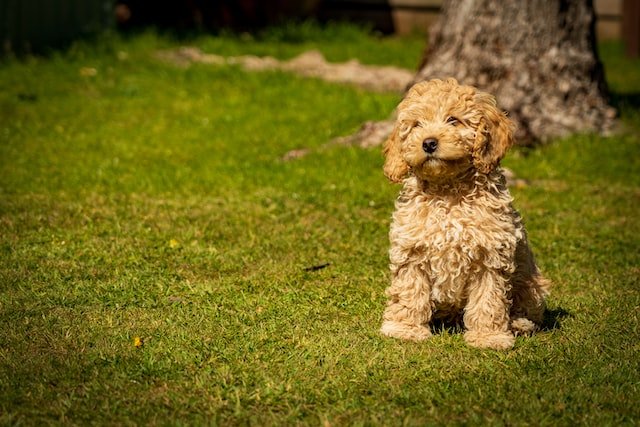Petite designer pets are popular, and one of the most adorable breeds from this group is the Jackapoo. Also known as the Jack-a-Poodle, this pup is crossbred from the Jack Russell Terrier and the Poodle.
With both parent breeds having a considerably small stature, the Jackapoo comes out quite petite. Regardless, it is highly intelligent, energetic, and perfect for families looking to make a pet addition.

If you’re looking to adopt one, you’re in luck. Here’s all you need to know before bringing a Poo Jack into your apartment. Particularly, find out about its health, personality, grooming, and exercise requirements below.
Jackapoo Facts and Figures Summary
| TRAITS | DETAILS |
|---|---|
| Name | Jackapoo |
| Other names | Jackadoodle, Jack-A-Poodle, Poo Jack |
| Parents | Jack Russell Terrier, Poodle |
| Life span | 12-15 years |
| Height | 10-16 inches |
| Weight | 13-25 pounds |
| Personality | Energetic, Alert and Loyal |
| Temperament | Friendly, Affectionate and Adaptable |
| Shedding Level | Low |
| Puppy cost | $300 – $900 |
What is a Jackapoo Mix?
The exact origin of most designer dogs is usually difficult to trace. However, many long-time breeders and commentators pin the emergence of the Jackapoo in the 1980s. Poodles became the subject of pop culture during this period, causing an increase in cross-breeding activities with other pure breeds.
In turn, we saw development in the intelligent traits of the Poodle through mixes with similarly behaved dog breeds. More information about the Jackapoo mix necessary leads back to the history of the parents.
Jack Russell Terriers emerged in Southern England during the 1800s as a sub-type of working terrier dogs. They were first bred by Reverend John Russell who intended to develop a terrier strain to hunt foxes.
Owing to their fox-like stature and double coat, it is believed that the Jack Russell Terrier was mixed with the Bull Terrier and Beagle. The composition of this breed of terrier makes it adaptable to hunting and family uses. It has a considerably longer leg than most terriers as well as high energy levels.
On the other hand, the Poodle is a luxurious yet ancient purebred dog tracing its origins to Germany. They were originally used as waterfowl retrievers, even though this hunting element of their temperament has dwindled over time.


In 2009, the International Designer Canine Association recognized the breed. Similarly, the Jackapoo enjoys recognition from the Designer Dogs Kennel Club and the American Canine Hybrid Club.
Jackapoo Health & Appearance at a Glance
The Jackapoo takes on the exact high energy level and small size of its parent breeds. However, the coating and appearance of the Poodle are mostly predominant in the mixed breed pooch. Curious about what to look out for in a Jackapoodle? Here are some of the major physical attributes and health configurations of this hybrid.
Build, Height and Weight
Weighing between 13 to 25 lbs, the Poo Jack is one of the smallest Poodle Designer dogs. It takes up this unintimidating size from the Jack Russell Terrier which typically has a body mass of 18 lbs.
The Jack-a-Poo stands at a height of 10 to 16 inches, an almost exact aggregate of its two progenitors. Interestingly, your dog may be even smaller if its Poodle parent is a Toy or Miniature.
Generally, these dogs have muscular hindquarters, a major feature of their hunting terrier ancestor. It also has a wide muzzle, padded round feet, and a flat head. Like most other poodles, its ears bend over to reveal an overall alert disposition.
Colors and Coat
There is no universal coating for the Jackapoo, and your pooch’s body largely depends on the more dominant parental gene. The common possibilities are a short curly coat or otherwise coarse, fluffy, or straight coats.
Your Jackapoo could come in about five color variants, namely black, brown, white, blue and gray. This breed also has brown eyes and a black nose. Its tail is usually long but many designer dog owners dock a Jackapoo’s tail for aesthetic purposes.
Life Expectancy and Possible Health Issues
The Jack-a-Poo has a lifespan extending up to 15 years, which is the average for most dog breeds. And like other hybrids, it sheds away most of the health deficiencies of its purebred parent. So, it is mostly healthy, having no serious genetic issues as a pup.
In less healthy Jackapoos, some possible health challenges include epilepsy, bloat, eye problems, hip dysplasia, and hypothyroidism. Dog owners and vets also report instances of patellar luxation, Addison’s disease, skin disorders, and Von Willebrand’s disease in this breed.
More often than not, these problems are mild but you should see a doctor if your furry friend comes down unwell. Also, with a good diet and regular visits to a vet, you can prevent or treat these diseases early.
Jackapoo Personality Traits
Energetic is the first word that comes to mind when describing the Poo Jack mixed breed. They also tend to be very playful, especially around their humans and other dogs. You’ll also find that the breed is very loyal and tends to stick to its owner as often as possible. Jackapoos are similarly alert, displaying a knack for hunting like their terrier predecessor.
Importantly, this hybrid is intelligent, making training considerably easy to train. If adopted as a working dog, the Jackapoo can prove quite useful. But in many instances, if left alone, your pooch can grow stubborn and resistant to instructions. So, you may want to watch out for this trait and caution it early enough.
Jackapoo Temperament and Instincts
This breed has the tendency to bark heavily if not properly curtailed. Also, their connection to the Jack Russell Terrier makes them a curious hybrid. So, it wouldn’t be strange for your Poo Jack to be caught digging up soils. However, it’s important to limit this behavior and completely prevent its occurrence indoors.
Jackapoodles are highly affectionate pets, mixing well with other pets and members of a family. And while it has a tendency to howl at suspicious visitors, it is mostly friendly with strangers during a walk.
A major positive of taking in a Poo Jack is its adaptability. This instinct may sometimes clash with its playful personality. For instance, your Jackapoo may adapt to your small apartment. However, it won’t be able to help its occasional desire for more space to jump around.
How to Care for a Jackapoo?
If you are an experienced dog owner, caring for the Jackapoo is not significantly different from other similar small-sized dog breeds. Nonetheless, peculiar health issues and the need for physical stimulation may demand more specific attention. Here’s a comprehensive guide to the processes of grooming and feeding your Poo Jack, among others.

Grooming and Shedding
Depending on which parent’s gene is more dominant, your Jackapoo’s coat may vary from others. The possible coating of your pooch could range from straight to curly and wiry hair. But not to worry, the breed is low maintenance and sheds its hair less frequently.
You should consider brushing your pet’s hair once a week. This activity would help detangle its coat and prevent knots that make the Jackapoo susceptible to picking up foreign objects. You may also choose to take your pet for a bath once every fortnight or as often as needed.
While all Jackapoos are tolerant of hot and cold weather, their coating plays a huge role. If it has an undercoat like its Jack Russell Terrier parent, make sure to keep your pet dehydrated during heat waves. But if it inherits the Poodle’s coating, it would need extra care, like clothing during cold conditions.
Diet and Feeding
As a small breed with high energy levels, your Jackadoodle’s diet should include a rich amount of minerals and vitamins. Avoid meals with high concentrations of saturated fat, grains, or carbs. Instead, opt for kibbles or formulated dog food that is fitting for small dog breeds.
It’s important to divide your dog’s daily meal across three servings to prevent overeating. You can cut down the servings to twice daily as your dog grows older. Meal portions should reflect your dog’s size, age, and activity level. For more specific dietary recommendations, visit your veterinarian.
Activity and Exercise Requirements
Jackapoos aren’t lazy lap dogs. They love to run around and jump over barriers. Their highly energetic nature and immense activity levels are a copypaste of the original Jack Russell Terrier. So, they tend to demand more intensive exercise time than most other breeds.
You should ensure to dedicate about one hour of exercise daily to your Poo Jack. This time should include several minutes of outdoor walks and mental stimulation. Taking your dog to the park is also a good shot at exercising. Its natural prey drive will lead it to chase birds and rodents.
All outdoor exercises should be done with close supervision because Jackapoos have a wanderlust potential. Similarly, avoid excessive physical activity like running, as it may negatively affect your pooch’s joints. It will also be helpful to keep your dog mentally alert with puzzle games at regular daily intervals.
How to Train a Jackapoo?
Generally, Jackapoos are quite easy to train. Since they are very intelligent dogs and always aim to please their owners, they pick up training information quickly. However, this has its negative sides as they are similarly receptive to bad habits and can be stubborn with unlearning. So, introduce your pup early enough to positive behaviors.
Considering their potentially stubborn nature, Jackapoos can rebel against scolding. Instead, approach them with positive reinforcement and lots of treats. Unlike exercises, training periods should be kept at a buck and fragmented with rewards each time.
Known Jackapoo Health Problems
Jack-a-poos have a generally healthy disposition, but like most cross breeds, they are prone to some specific diseases. You could watch out for mild complications like obesity, deafness and dental diseases.
Other major illnesses and deficiencies include hip dysplasia, Addison’s disease, Von Willebrand’s disease and patellar luxation. They are also susceptible to allergies, hypothyroidism, skin disorders, eye conditions and Cushing’s diseases.
Frequent visits to your vet, routine exercises and a proper diet will help prevent some of these infections.
Daily Routine for a Happy Jackapoo
Your Jackapoo’s day begins with a short potty break. Afterward, you could take it on a short morning walk. This breed has a strong tendency to experience bloat. So, it is best to have up to 45 minutes intervals between feeding and exercise.

Meals for your pup should be split across three servings in the morning, afternoon and evening, respectively. As night-time draws nearer, a long walk will be a perfect end to the day. But before then, ensure your dog takes regular naps during the day.
Is a Jackapoo the Right Dog for You?
If your perception of the perfect dog is a small, energetic designer puppy with an affectionate appeal, then you should get a Jackapoo. The dog adapts extremely well to family circles, so there would be no problem bringing one into your home.
As an intelligent and loyal breed, Jackapoos are suitable for first-time dog owners. However, you need to give them enough time and affection to prevent separation anxiety. The cost of maintaining the Jack-a-Poo is also pocket friendly, with food costing about $30 a month and annual care expenses estimated at $1,500.
Should You Buy Or Adopt A Jackapoo?
A Jackapoo puppy costs between $300 and $900. Unfortunately, though, there are not many breeders around, so you may want to opt for adoption. You can find a Jackapoo at rescue shelters near you, giving you the noble opportunity to help an abandoned pooch.
Adopting a Jackapoo requires you to pay attention as you’re largely unaware of its health history and habits. So, if you’re lucky to find a breeder, you may buy one but all things being equal, adopting a puppy is always a recommended option.
FAQs about the Jackapoo Cross-Breed
The Poo Jack is a relatively small pet, taking a large chunk of its size from both parents. On average, your adult Jackapoo can grow to weigh about 13 to 16 pounds. At the higher end of the spectrum, considerably bigger Jackapoos weigh 25 pounds and have a shoulder height of up to 16 inches.
Yes, it is a natural instinct for your Jackapoodle puppy to bark a lot. This trait is obtained as a result of its high energy and extremely protective ancestor, the Jack Russell Terrier. Ensure you spend enough time with your pooch, as separation anxiety sometimes triggers barking. Also, see to it that your dog is fully trained, gets sufficient exercise, and is rewarded for calm behaviors.
Of course, the Jackapoo makes for a very affectionate and loyal dog. So, it’s quite fitting for a small family. It also blends perfectly with kids and other small pets. If you’re adopting one, it’s best to have a large space for your furry friend to explore its high energy. Also, be willing to give all the required attention.
Poo Jacks have an extremely low boredom threshold, and frequent walks contribute to helping them effectively channel their energetic personality. Dog owners are advised to reserve about 45 minutes each day to walk Jackapoos. You could divide this time into a short 15-minute stroll in the morning and a longer 30-minute walk.
Yes, the Jackapoo is arguably one of the most intelligent cross breeds. Not only are they intelligent, but they are also lively and eager to please their owners. This attribute makes them easier to train than most breeds and makes them learn faster.
Your Jackapoo undergoes bodily development for about eight months. After this period, it becomes fully formed and may attain a height of 10 to 16 inches. However, some dogs may take longer to mature, reaching full adult size after 12 months.
No dog is completely hypoallergenic, but the Jackapoo is one of those dogs that are quite safe for people with allergies. It is a low shedder, and due to its Poodle ancestry, it can be deemed more hypoallergenic than most other common breeds.
